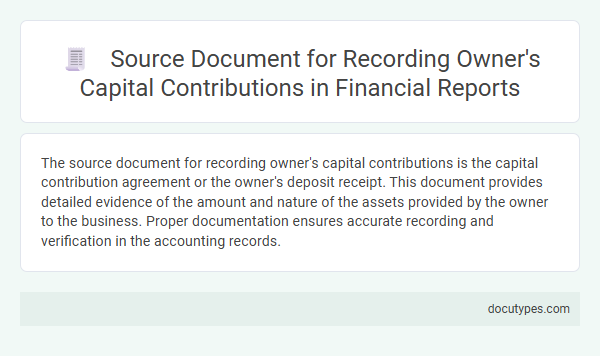The source document for recording owner's capital contributions is the capital contribution agreement or the owner's deposit receipt. This document provides detailed evidence of the amount and nature of the assets provided by the owner to the business. Proper documentation ensures accurate recording and verification in the accounting records.
Introduction to Source Documents in Capital Contributions
Source documents provide the original evidence for financial transactions, ensuring accuracy and transparency in accounting. In the context of owner's capital contributions, these documents are crucial for recording and verifying the infusion of assets into a business.
Source documents for owner's capital contributions commonly include bank statements, deposit slips, and contribution agreements. These records authenticate the transfer of cash, property, or other assets from the owner to the company. Proper documentation supports accurate financial reporting and compliance with auditing standards.
Importance of Accurate Owner’s Capital Documentation
The source document for recording owner's capital contributions is a critical financial record that verifies the investment made by the owner into the business. Accurate documentation ensures the integrity of your financial statements and supports transparent business operations.
- Proof of Investment - Source documents such as bank deposit slips or check copies confirm the exact amount contributed by the owner.
- Legal Record - These documents establish a legal foundation for ownership equity, essential during audits or legal scrutiny.
- Financial Accuracy - Proper documentation prevents errors in capital account balances, maintaining reliable financial reporting.
Common Types of Source Documents for Capital Contributions
The source document for recording owner's capital contributions is essential for maintaining accurate financial records. Common types of source documents include bank deposit slips, capital contribution agreements, and cheques from the owner. You should retain these documents to ensure proper validation of your capital entries in the accounting system.
Key Information Required in Source Documents
Source documents for recording owner's capital contributions serve as the foundation for accurate financial reporting. These documents provide essential details that verify the amount and nature of the contributions made by the owner.
- Identification of Contributor - The document must clearly state the name of the owner making the capital contribution to establish accountability.
- Description of Contribution - It should specify the type of asset or cash contributed, detailing what is being added to the capital.
- Value of Contribution - The document must include the monetary value assigned to the contributed assets or cash to ensure precise recording in accounting books.
These key pieces of information are critical for maintaining transparent and accurate capital account records.
Procedures for Recording Owner’s Capital Contributions
The source document for recording owner's capital contributions is typically the capital contribution agreement or the owner's investment statement. This document provides detailed information about the amount, date, and nature of the capital contributed to the business.
Procedures for recording owner's capital contributions involve verifying the source document and accurately entering the contribution details into the accounting system. You must ensure the transaction is reflected in the owner's equity account to maintain precise financial records.
Internal Controls over Capital Contribution Documentation
The source document for recording owner's capital contributions is typically the capital contribution agreement or investment receipt. These documents provide formal evidence of the amount and terms under which the owner contributes assets to the business.
Strong internal controls over capital contribution documentation ensure accuracy and prevent unauthorized transactions. You should implement regular verification processes and maintain secure records to protect the integrity of capital accounts.
Legal and Regulatory Requirements for Source Documents
The source document for recording owner's capital contributions is essential for maintaining accurate financial records and ensuring compliance with legal standards. These documents serve as proof of investment and support the legitimacy of capital entries in accounting books.
- Capital Contribution Agreement - A formal written contract specifying the details and terms of the owner's investment in the business.
- Bank Deposit Slips - Verified bank statements or deposit receipts confirming the actual transfer of funds from the owner to the business account.
- Legal Regulatory Compliance - Source documents must adhere to jurisdictional laws and accounting standards such as GAAP or IFRS to validate the contributions for auditing purposes.
Impact of Source Documents on Financial Reporting
| Source Document for Recording Owner's Capital Contributions | Capital contribution agreements, bank deposit slips, and stock issuance records serve as primary source documents for recording owner's capital contributions. These documents provide verifiable evidence of funds or assets introduced by the owner into the business. |
|---|---|
| Role of Source Documents in Financial Reporting | Source documents ensure accuracy and reliability in the financial statements by establishing a clear audit trail. They enable proper recognition and measurement of equity transactions, supporting compliance with accounting standards. |
| Impact on Financial Statement Integrity | Accurate source documentation minimizes errors in capital accounts and reduces the risk of financial misstatements. Transparent records increase stakeholder confidence and enhance the credibility of reported equity figures. |
| Effect on Audit and Compliance | Source documents are critical during financial audits as they substantiate capital inflows. Regulatory bodies rely on these documents to verify capital adequacy and ownership claims, ensuring adherence to legal requirements. |
| Influence on Business Decision-Making | Reliable capital contribution records allow management to assess financial strength and liquidity accurately. This information supports strategic planning, investment decisions, and capital structure optimization. |
Common Errors in Documenting Owner’s Contributions
What is the source document for recording owner's capital contributions? The primary source document is the capital contribution agreement or shareholder agreement, which details the amount and terms of the owner's investment. Accurate documentation ensures proper recording in financial statements and legal compliance.
What common errors occur in documenting owner's contributions? Common mistakes include failing to specify the contribution amount, neglecting to formalize agreements in writing, and not recording non-cash contributions accurately. These errors can lead to discrepancies in equity accounts and complicate audits or financial reviews.
What Is the Source Document for Recording Owner's Capital Contributions? Infographic

